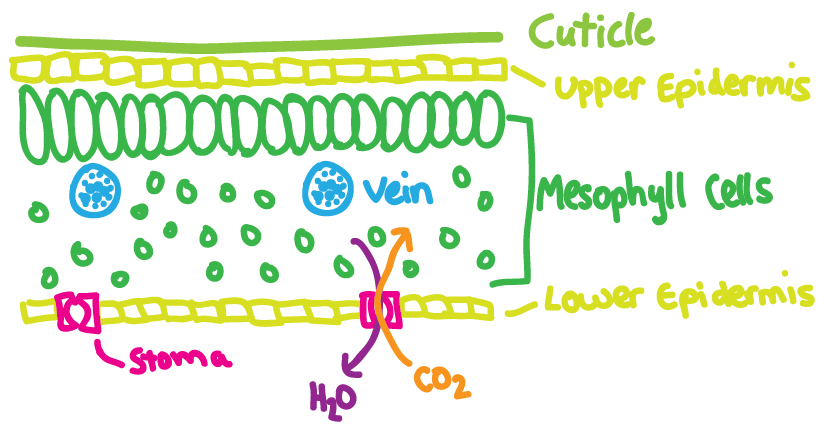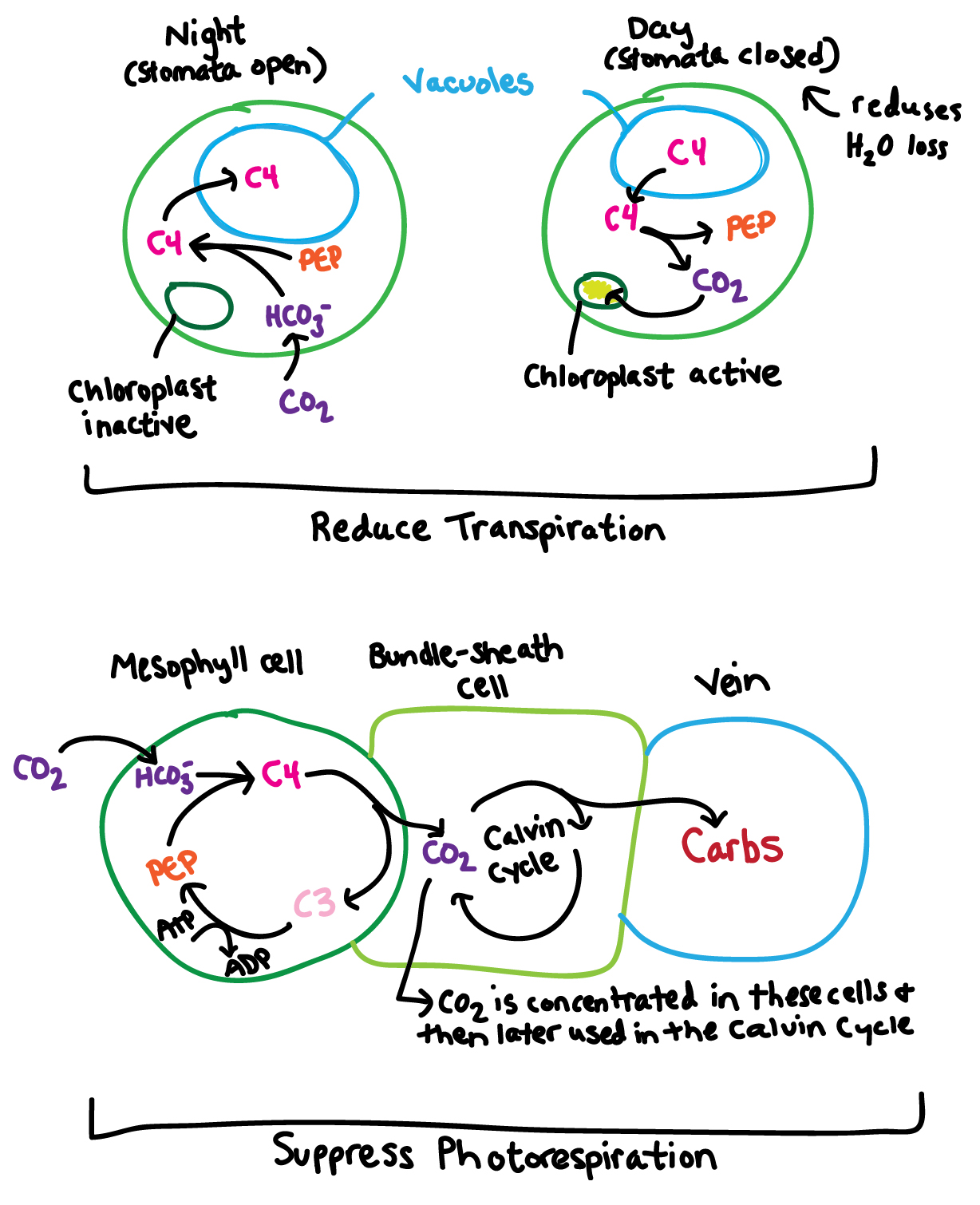CHAPTER SUMMARY
29.1 THE EVOLUTION OF LAND PLANTS FROM AQUATIC ANCESTORS INTRODUCED A MAJOR CHALLENGE FOR PHOTOSYNTHESIS: ACQUIRING CO2 WITHOUT LOSING EXCESSIVE AMOUNTS OF WATER.
- Early branching land plant lineages, commonly grouped as bryophytes, balance CO2 gain and water loss passively, photosynthesizing in wet conditions and tolerating desiccation in dry ones.
- Vascular plants actively regulate the hydration of their photosynthetic cells.
29.2 LEAVES HAVE A WAXY CUTICLE THAT RETARDS WATER LOSS BUT INHIBITS THE DIFFUSION OF CO2, AND PORES, CALLED STOMATA, THAT REGULATE CO2 GAIN AND WATER LOSS.
- The low concentration of CO2 in the atmosphere forces plants to expose their photosynthetic cells directly to the air. The outward diffusion of water vapor leads to a massive loss of water.
- The waxy cuticle on the outside of the epidermis slows rates of water loss from leaves but also slows the diffusion of CO2 into leaves.
- Stomata are pores in the epidermis that open and close, allowing CO2 to enter into the leaf but also allowing water vapor to diffuse out of the leaf.
- CAM plants capture CO2 at night when evaporative rates are low. During the day, they close their stomata and use this stored CO2 to supply the Calvin cycle during the day, resulting in increases in the exchange ratio of CO2 and H2O.
- C4 plants suppress photorespiration by concentrating CO2 in bundle-sheath cells. The buildup of CO2 in bundle-sheath cells results from the rapid production of C4 compounds in the mesophyll cells, which then diffuse into the bundle-sheath cells and release CO2 that can be used in the Calvin cycle.
29.3 XYLEM ALLOWS VASCULAR PLANTS TO REPLACE WATER EVAPORATED FROM LEAVES WITH WATER PULLED FROM THE SOIL.
- Water flows through xylem conduits from the soil to the leaves.
- Xylem is formed from cells that lose all their cell contents as they mature.
- Xylem conduits have thick, lignified cell walls. Water flows into xylem conduits across small thin-walled regions called pits.
- Xylem conduits are of two types: tracheids and vessels. Tracheids are unicellular xylem conduits; vessels are formed from many cells.
- The driving force for water movement in xylem is generated by the evaporation of water from leaves. Because of the strong hydrogen bonds between water molecules, water can be pulled from the soil and transported through xylem.
- Pulling water through xylem creates the risk of mechanical failure, either by the collapse inward of conduit walls or by cavitation in which a gas bubble expands to fill the entire conduit.
29.4 PHLOEM TRANSPORTS CARBOHYDRATES AND SUPPORTS THE GROWTH AND RESPIRATION OF NON-PHOTOSYNTHETIC ORGANS SUCH AS STEMS AND ROOTS.
- Phloem transports carbohydrates to the non-photosynthetic portions of the plant for use in growth and respiration.
- Phloem transport occurs through sieve tubes, which are formed from elongate cells that are connected end to end by sieve plates. Sieve plates contain large pores that allow phloem sap to flow from one sieve tube cell to another.
- The active loading of solutes brings water into sieve tubes by osmosis, increasing the turgor pressure. At sites of use, the removal of solutes leads to an outflow of water and a drop in turgor pressure.
- The difference in turgor pressure drives the movement of phloem sap from source to sink.
- Carbohydrates exuded from roots provide carbon and energy sources for the rhizosphere microbial community.
29.5 ROOTS EXPEND ENERGY TO OBTAIN NUTRIENTS FROM THE SOIL.
- The endodermis allows roots to control which materials enter the xylem. The uptake of solutes by roots is therefore highly selective.
- Symbiotic associations with fungi allow plants to exchange carbohydrates for assistance in obtaining phosphorus from the soil.
- Plants supply carbohydrates to symbiotic nitrogen-fixing bacteria in exchange for nitrogen.
- Nitrogen fixation results in a net increase in ecosystem nitrogen.
- Agricultural productivity is closely linked to nitrogen supply.
Self-Assessment Question 1
Explain why vascular plants are better able to sustain photosynthesis than are bryophytes.
Show Model Answer
Model Answer:
Vascular plants are better able to sustain photosynthesis than bryophytes because they are able to take up water from the ground through their root system instead of being dependent on the level of water on the surface. Bryophytes dry out when not enough water is available at the surface, and, as a result, they lose the ability to photosynthesize.
Self-Assessment Question 2
Explain why transpiration is best explained as a consequence of acquiring CO2 from the atmosphere, as opposed to temperature regulation, nutrient transport, or utilization of water as a substrate in photosynthesis.
Show Model Answer
Model Answer:
Transpiration is the loss of water vapor from the leaves through evaporation. It is a consequence of acquiring CO2 from the atmosphere. As CO2 diffuses into the leaf through stomata, water vapor diffuses out at a faster rate. Thus, several hundred molecules of water are lost for every molecule of CO2 acquired for photosynthesis.
Self-Assessment Question 3
Draw and label the features of a leaf that are necessary to maintain a well-hydrated interior while still allowing CO2 uptake from the atmosphere.
Show Model Answer
Model Answer:

Self-Assessment Question 4
Diagram how the movement of solutes results in the opening and closing of stomata.
Show Model Answer
Model Answer:

Self-Assessment Question 5
Diagram how the enzyme PEP carboxylase allows CAM plants to reduce transpiration rates and C4 plants to suppress photorespiration.
Show Model Answer
Model Answer:

Self-Assessment Question 6
Contrast how transport is generated in xylem and in phloem.
Show Model Answer
Model Answer:
Water transport in xylem is driven by an evaporative pump whose driving force is generated in the leaves. Thus, water moves from the roots to the leaves in xylem. In contrast, the transport of sap in the phloem can go in either direction, from tubers to young leaves or from leaves to roots, for example.
Phloem transport is driven by differences in turgor pressure. Water is drawn into the phloem by osmosis, in response to the active transport of sugar molecules into the phloem. The influx of water increases turgor pressure at the source. Water leaves the phloem when sugar molecules are transported out into the other plant tissues. The outflow of water reduces turgor pressure at the sink. Water flows from the region of high turgor pressure to the region of low turgor pressure.
Self-Assessment Question 7
Describe the structure of xylem conduits and sieve tubes in relation to their function.
Show Model Answer
Model Answer:
Xylem conduits are basically hollow tubes made up of thick cell walls. There is no cytosol or internal organelles. Water is able to flow easily through the hollow tubes.
Phloem consists of sieve tubes that transport carbohydrates. They are also elongated, but they contain cytoplasm and a few organelles. The cytoplasm provides a medium in which to transport the carbohydrates, called phloem sap.
Self-Assessment Question 8
Explain why phloem is necessary to produce roots.
Show Model Answer
Model Answer:
Phloem transports sugars and other nutrients to non-photosynthetic organs, like the roots.
Self-Assessment Question 9
List four adaptations of roots that enhance the uptake of nutrients from the soil.
Show Model Answer
Model Answer:
Four adaptations of roots that enhance the uptake of nutrients from the soil are (1) root hairs of the epidermis; (2) the ability of endodermal cells to control which nutrients enter the vascular system; (3) the beneficial association of mycorrhizal fungi; and (4) the beneficial association of bacteria in the root nodules of some plants like legumes.